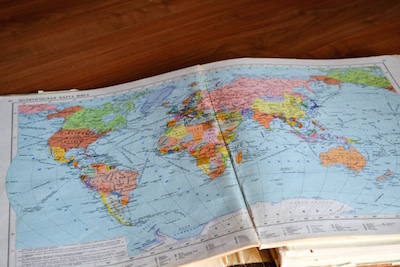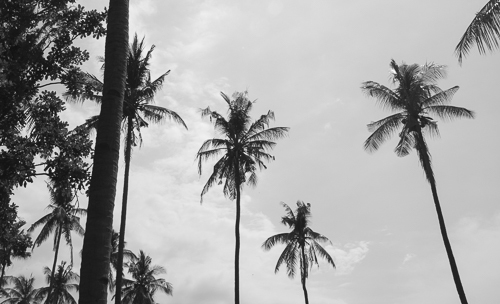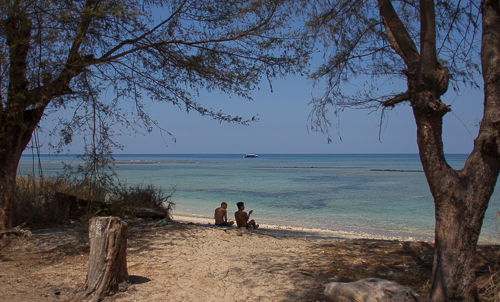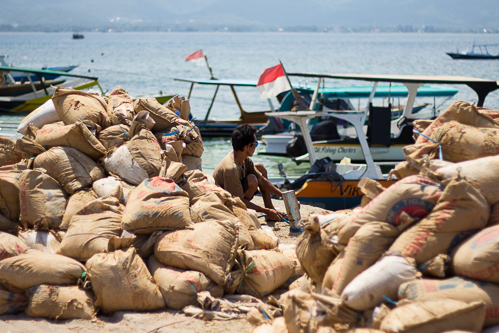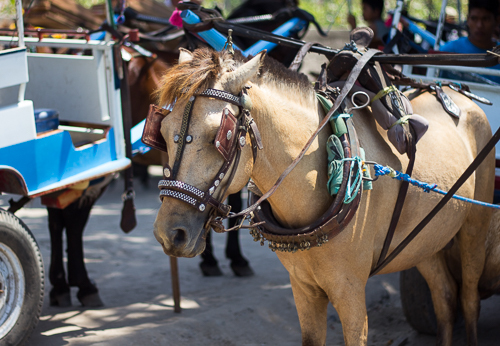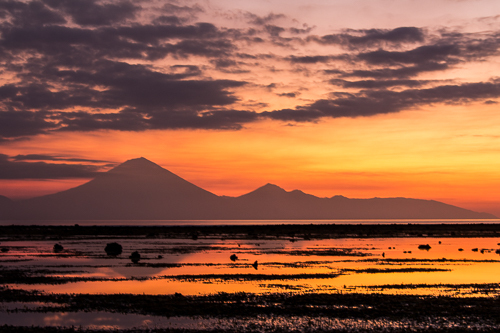Rolf Potts's Blog, page 4
January 28, 2016
The reality behind dual nationalities and multiple passports
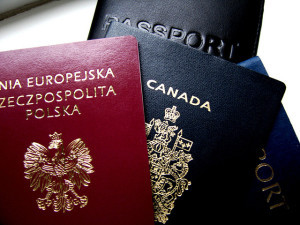 The article, “Carrying Several Passports? It’s Not Just for Spies”, discussed the benefits of carrying multiple passports from different countries.
The article, “Carrying Several Passports? It’s Not Just for Spies”, discussed the benefits of carrying multiple passports from different countries.
The topic of multiple nationalities and passports tends to be filled with hype and mystery, but it’s really simple. Your ethnicity, birthplace, and religion can be the basis of dual citizenship. If your spouse has dual citizenship, you may be eligible for it too. From the article:
“The fact is people don’t think about it until it is pointed out to them,” said Jan Dvorak, president of Travisa, a passport services company in Washington. Some Americans, he said, “don’t realize that they actually have dual nationality.”
While there are no hard numbers, more Americans seem to be trying to qualify for additional passports. “Savvy travelers and business travelers want to make sure they have two passports based on nationality because there are certain advantages,” Mr. Dvorak said.
These advantages include fewer travel and work restrictions, and, at times, cheaper visa application fees.
There are also other ways to acquire dual citizenship if you’re not qualified for the above reasons. If you have hundreds of thousands of dollars lying around somewhere, you can look for a country with economic citizenship or citizenship-by-investment programs. Dominica and Saint Kitts and Nevis are examples of countries that have this option, but approval is not guaranteed. Because of this many people view these fast-track options as scams.
Other countries have a less direct route. Instead of granting you citizenship after your investment, you are given a permanent residency visa which will allow you to apply for citizenship in a few years.
When thinking about getting a second passport, remember that each country has its own laws on dual nationalities. Some require you to relinquish one nationality for the other. Also, the internet is filled with scams and misinformation on this subject. Be sure to consult an immigration lawyer and other official sources before you take any action.
Do you have multiple nationalities? How do you deal with this when you travel?
Ready plan a Round The World adventure?
Sign up for the free e-course >
Image: Baigal Byamba (flickr)
Image: Ðariusz (flickr)
Original article can be found here: The reality behind dual nationalities and multiple passports
Travel Mindset – How can we get it at home?
How do you do it? What if you can’t find the cash for the next adventure? What if the money isn’t there for that much-needed excursion or journey with a close friend, loved one or solo expedition? Do you curl up in a little ball and try to find a way for the money to turn up or do you bust out of bed and greet the day with a smile? These may be extremes, but somewhere in between is the middle point of finding the travel mindset.
I’ve been lucky to meet many other travelers.
Some take the once a year holiday, some take those few months and gallivant, some move overseas and enjoy life as expats for a while and still others find a happy medium. When you’re used to one of these and then it stops or changes – the blues have an ability to set in. For some it’s the sadness of what used to be, for others it’s the glimpse again of what might have been and still others long for the unknown of what travel brings. How do you handle it?
I’ve tried, for a while, to embrace a travel mindset.
There are times in life when larger scale travel is possible, but others when it’s not. Maybe you’re waiting to earn more money for the next jaunt. Maybe you’re enjoying where you are and not ready to move again. Perhaps friends, family, or commitments have taken heed and are the needs of the day. No matter – how do you find those travel joys in the intermittent weeks?
To me, the travel mindset is just that. The ability to find the joy in the everyday and the ease in the unknown, a ‘go with the flow’ attitude, the flexibility when plans change or go awry, the determination to succeed and attain a goal, positivity, happiness in the simple and a ‘can do’ attitude. These can be showcased in a variety of ways. For some, it might mean grabbing those few minutes in the morning to center oneself for the day or enjoy that cup of something while inhaling the purity of nature. For others, it might be taking time out to find exploration nearby (whether it’s in your reach or an internal practice). Maybe you go to that aquarium for the day. Maybe you take that local hike or new yoga class. Maybe you hit that tourist spot – you know the one you only go to when people visit? Maybe it’s heading out for the day with no plans in sight and seeing where your wandering leads. Travel mindset is an attainable goal.
Your local is someone else’s adventure.
No matter where we live, there’s something special. Interacting with locals when traveling often provides that extra level of a journey that isn’t listed in a book or found on a website. You are that local. You have that added bonus – all we need to do is embrace it. Sometimes it means stepping out of your comfort zone and trying a new cuisine in your hometown. Sometimes it means jumping in the car and seizing the day heading out to a place you’ve never before been. Other times it means letting the day take you places you least expected.
If you’re the traveler who doesn’t let rain stop you from seeing the sights on the day allotted by your tour – embrace that same attitude when at home. If you’re the traveler who enjoys savoring those special moments or intricate details of a place – embrace the same attitude at home. If you’re the traveler who doesn’t let a little sickness stop you from taking in the thing of the day – embrace that same attitude at home. If you’re the traveler who when a supposed to be sunny and warm holiday turns into a rainy one puts on your sweats and heads out to the lounge chair book in hand and hood up – embrace that same attitude at home.
Perhaps it’s about letting go a bit, realizing and accepting life’s imperfections and making the best out of the situation at hand. Find the good, the happy and the ease in the every day and explore life where you are. Channel that same zest for wonder you find on a travel day and bring that travel day to you. Work towards the happy, the curious, the inquisitive and the wonder…the travel mindset will follow suit.
To follow more of Stacey’s adventures…check out her blog.
Photo Credit:
John-Mark Kuznietsov
Original article can be found here: Travel Mindset – How can we get it at home?
January 19, 2016
The worst tourists in the world
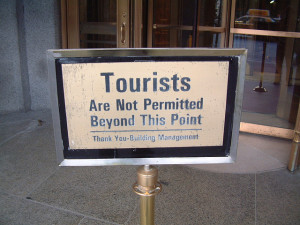 I read with interest a recent study by the Trans-Global Association for Travel and Tourism Commerce, which rated the behavior of tourists from all the world’s industrialized countries. Consistently ranking last in the study — bottoming out in categories ranging from airline etiquette to podiatric hygiene — were travelers from Great Britain. “This settles it,” a TATTC spokesperson was quoted as saying. “The British are the worst tourists in the world.”
I read with interest a recent study by the Trans-Global Association for Travel and Tourism Commerce, which rated the behavior of tourists from all the world’s industrialized countries. Consistently ranking last in the study — bottoming out in categories ranging from airline etiquette to podiatric hygiene — were travelers from Great Britain. “This settles it,” a TATTC spokesperson was quoted as saying. “The British are the worst tourists in the world.”
Actually, I’m just kidding. There is no such thing as the Trans-Global Association for Travel and Tourism Commerce. I made it up just now, because I know that people like to obsess over international rankings, and I’ve been looking for a chance to poke fun at the British.
Mind you, I don’t really think the British are bad tourists. To the contrary, I’ve usually found travelers from the U.K. to be friendly, well read, and quite prolific in their wanderings. You can find Brits in all corners of the world, from Valparaiso to Vladivostok, and they most always make good travel companions.
The problem I have with the British, however, is that — to a bigger extent than other travelers I’ve met — they seem to be obsessed with stereotypes of national character.
I used to think that British travelers were just disproportionately gung-ho about bashing Americans (apparently, we’re noisy, over-religious, and we’re supposed to use a “u” when we spell “color”). Over time, however, I’ve discovered that Brits also hold strong preconceptions about nearly every nationality in the travel milieu, from the Swiss (officious and dull), to the Japanese (unimaginative and over-polite), to the Argentines (narcissistic and sex-obsessed).
In fact, were I to base my perceptions entirely on the basis of Britannic generalizations, I could very well conclude that the world’s worst tourists are roughly categorized as follows:
Americans: Ignorant. Loud. Oblivious to surroundings. Insincere.
French: Rude. Bigoted. A trifle out of touch with reality.
Germans: Humorless. Rule-obsessed. Unfriendly. Stubborn.
Israelis: Rude. Cheap. Arrogant. Cliquish.
Canadians: Exactly like Americans, but more polite, less ignorant, and twenty times more boring.
Before I go any further here, I will admit three things. First, I realize the circular logic inherent in making generalizations about the generalizations of British travelers (and I apologize if you happen to be one of those Brits who isn’t a nationalistic busybody). Second, I realize that half the readers who’ve stumbled across my column this week have skipped straight from the headline to the above list, and are now typing angry things in the comments section below (especially if they happen to be American, French, German, Israeli, or Canadian). And, third, I’ll concede that the British fixation with national character reveals an impressive knack for world geography (in contrast to us Americans, who associate “Vienna” less with a European city than with canned snack sausages).
Were I a more meticulous analyst, I might posit that this British tendency is the cultural residue of Victorian-era self-superiority (vivid examples of which can be found in most any 19th century British travel guidebook, one of which described Valencian Spaniards as “perfidious, vindictive, sullen, mistrustful, fickle, treacherous, smooth, empty of all good, snarling and biting like hyenas, and smiling as they murder”). Since I’m no scholar, however, I’ll just point out that the British affinity for stereotyping their fellow wanderers is a mostly harmless amplification of what all travelers do from time to time.
The problem here is that assessing your travel companions by nationality is rarely an earnest inquiry so much as it is a dull parlor game — an empty exercise in rhetorical one-upmanship. The worst travelers in the world are, after all, the rude, small-minded ones — and rude, small-minded travelers can hail from any nation.
Moreover, most hostel-lounge arguments about which countries export good or bad travelers fail to take in the local perspective. A few years ago, a survey conducted by international tourist offices found that the oft-disparaged Germans and Americans were rated most favorably by host communities around the world. This rating didn’t hinge on cultural or aesthetic opinions, but the simple fact that Germans and Americans spend money more generously than their tourist counterparts. Economic benefit, it would appear, was more important to local hosts than the common traveler obsessions with fashion, geopolitics, and collective behaviors in tacky backpacker nightclubs.
My point, then, is a simple one: The next time you find yourself in a heated argument over which nation produces the best or worst tourists, this is probably an indicator that you’ve been spending too much time yapping in hostel lounges and not enough time outside having engaged adventures.
And that, in its own way, means you’re a bad tourist.
Tip sheet: How to avoid being an ugly American (or wherever it is you’re from)
1) Study up on the local culture.
Get to know something about a place before you go there. Read novels and travel books about the region, and study guidebooks to learn about customs, manners, and cultural norms. Learn a few phrases of the language (such as greetings, thank yous, numbers, and food terms). Keep in mind that culture expresses itself at an instinctive level — not an intellectual level — and that different standards of time, courtesy, and personal service may apply in far-off lands.
2) Listen, and ask questions.
On the road, make it a habit to talk less and listen more. Travel is hardly the time to extol the virtues (or shortcomings) your home country; instead be curious about how people think in the place you’re visiting. Ask follow-up questions. Seek to maintain open-mindedness, which is a process of listening and considering — of muting your compulsion to judge what is right and wrong, good and bad, proper and improper, and having the tolerance and patience to try and see things for what they are.
3) Avoid arguing politics.
Avoid political proselytizing, regardless of which end of the political spectrum you think you represent. At home, political convictions are a tool for getting things done within your community; on the road, political convictions are a clumsy set of experiential blinders, compelling you to seek evidence for conclusions you’ve already drawn. If you really are liberal and enlightened (or conservative and informed) you will stop yammering about politics and learn something about the culture you’re visiting.
4) Avoid traveling in large groups.
If your sorority or church group or wiccan pilates club decides to travel to Paris or Quito or Bangkok as an eight-some, do everyone a favor and split into groups of two. This will make you less noisy, less self-enclosed, more approachable, and more open to what’s going on around you. If nobody wants to split off from the group with you, tackle the day solo. I guarantee that you will have more memorable adventures on your own than with a big group of travelers.
5) Give respect and you get respect.
Having rigid stereotypes about individuals you haven’t taken the time to know is silly in all contexts. As a representative of your own country, the best way to win respect is to show respect to everyone you meet. Odds are, your hosts will return the favor.
[This Rolf Potts article originally appeared in Yahoo! News on Oct. 9, 2006. All rights reserved.]
Ready plan a Round The World adventure?
Sign up for the free e-course >
Image: Prayitno Photography (flickr)
Image: Seth Werkheiser (flickr)
Original article can be found here: The worst tourists in the world
January 14, 2016
180 South and the quest for adventure
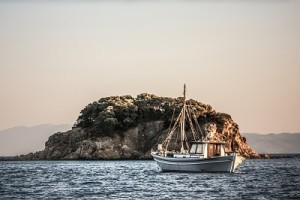 “The word adventure has gotten overused. For me, when everything goes wrong, that’s when adventure starts.” -Yvon Chouinard
“The word adventure has gotten overused. For me, when everything goes wrong, that’s when adventure starts.” -Yvon Chouinard
Quick, think of your most memorable travel experience.
Judging by the stories I hear from other travelers and the ones I tell, what sticks out for most are the moments when things went wrong, when for a little while things became uncertain and perhaps even risky.
Such moments may not be noted for their “fun” at the time, but later they stick out. The reason they stick out is because they seem more real. When things stop going as planned there is nothing to look forward to, there is just the moment your are in and that is where adventure starts.
The Chouinard quote above comes from a new film, 180 South, which is itself a tale of mishap and adventure. What makes 180 South worth seeing is that the mishaps, failed plans, and resulting adventure is conveyed in a way you seldom see when camera crews are there to record everything.
180 South is refreshingly raw, allowing a genuine sense of adventure to come through even in spite of all the filters of time and space between that adventure and in you in your armchair, watching. What makes the movie different is that it doesn’t have the slickly manufactured adventure you’re used to from Anthony Bourdain’s producers or the editors of Survivorman. Nor is there the manufactured adventure you find pedaled by volcano tour operators, scuba dive shops or jungle guides the world over.
There is nothing wrong with any of those things, but to paraphrase Chouinard, until something goes unexpectedly wrong, none of those cultivated experiences will fulfill the reason you left home in the first place — some universal longing for a genuine experience, a real adventure.
Such things are hard to come by these days. There are no dark spots left on Google Earth. Travel itself has become so easy you hardly notice it happening. There is a scene in the movie Snatch, which illustrates today’s travel in less than five seconds — a cab door closes, the character throws back a highball, a jet engine roars, another cab door closes and the next scene begins.
That’s not too far off how most of us travel. The door to your house closes behind you, an airplane engine hums and you’re there, where ever there may be.
Which isn’t to say there are not upsides. It’s wonderfully convenient to be able to fly around the world and cheap travel is a more democratized travel, available to people that would have never dreamed of traveling in previous centuries.
But there is also a price. We have removed most of the risk from travel. We have eliminated one of the original appeals of travel — to rediscover the authenticity of life through hardship, adventure, mishap and survival.
Without risk we have no chance for things to go wrong, we allow ourselves no challenges to overcome and end up returning home the same as when we left. Perhaps a bit more culturally aware, perhaps having met interesting people, but fundamentally unchanged in our existence, lacking the suffering and hardship that shapes our character and makes new people out of the exhausted molds we’re desperately trying to leave behind on the road.
When our travels rarely take us out of range of Twitter it’s hard to feel like we have been anywhere. We have gone nowhere inside, merely swapping the background music for a slightly different tune.
Without risk we miss the chance to fail, we miss the chance to see what happens when the mast breaks, when the rudder is lost and the ship starts to go down. It is rare these days that any traveler risks death, and yet, on some level, we travel precisely in order to risk something — to survive our own adventures, persevere when our plans go wrong and follow those detours until we arrive somewhere. There.
Most committed vagabonds, myself included, harbor some dream of buying a boat and sailing around the world. Most of us probably will never have the money, but the dream is telling. It’s partly the freedom of it perhaps, but it’s also I think the risk of it. After all travelers still die at sea all the time. It’s the appeal of risk that draws many to sailing, it requires a constant attention to the now, making you forget your plans entirely and that’s increasingly hard to find in your travels.
On some level I think we all feel this loss of risk. We’ve even invented ways to add that risk death back to our lives — bungee jumping from bridges, hang gliding from peaks or taunting Great White sharks from a cage.
We create artificial risks when we arrive because we have removed the fundamental risk of the journey.
Rolf recently posted a quote from Marian Botsford Fraser, part of which reads:
The heroic is no longer compelling. There are few places under the sun that cannot be found with the help of global positioning technology. Almost anyone can get to the top of a remote glacier and send a photo home via satellite phone.
There is in fact nothing heroic or compelling about getting on a plane and then finding yourself atop a glacier. Just close the cab door, have a drink and you’re there.
However, I do not think that just because travel is easy that that means the heroic is no longer compelling. It may not be compelling in travel writing, which is what Fraser is referring to, but it is certainly compelling to each of us on an individual level.
Like many things — religion, politics, etc — the heroic has, for better or worse, shifted from the public sphere to the private. We have internalized our sense of the heroic and we must live up to it alone.
It may be that these days no one finds an unadulterated and wild land teeming with adventure in Patagonia. In the film 180 South the characters are not even seeking an uncharted, wild land; they’re after their own uncharted, wild experiences.
In that sense, the Patagonia of 180 South becomes not place, but a journey searching for the personally heroic. Travel has never really been about getting “there.” No matter how burned into our imagination the destination may be, it’s never the place that matters. If it were just the places that mattered we could all save a lot of money and watch the highlights in HD on the National Geographic Channel.
But we don’t. We have this need to see it for ourselves, a need which I believe stems out of desire to see how we react to it, turning the “there,” the places, into a way of traveling within ourselves.
In 180 South “there” is ostensibly Patagonia, but there is no cab door closing, no highball tossed back, no plane ride. The film moves slowly, one scene sliding into the next until things start to go wrong. The there of Patagonia begins to fall away. The there becomes Rapa Nui, the there becomes Pichilemu, Chile, the there becomes Santiago, until finally, as Gertrude Stein wrote, “there is no there there.”
By the end of the film Patagonia is just a word for what we are all looking for, but it says nothing of where you actually arrive, if you will arrive at all or who you will be when you get there.
Ready plan a Round The World adventure?
Sign up for the free e-course >
Image: Manuel Inglez (StockSnap.io )
Image: Nick Karvounis (StockSnap.io )
Original article can be found here: 180 South and the quest for adventure
January 12, 2016
Travel ebooks you can download for free
 One of my favorite web tools is StumbleUpon, which allows me to randomly discover sites that suit my interests. Traveling is one of my listed interests, of course, so it was no accident that I literally “stumbled upon” the free online book “How to See the World: European Backpacking on $25 a Day or Less” by John Gregory. From the nuances of body language to practical tips on how to get cheaper airline tickets, this book covers information that new vagabonds will find useful.
One of my favorite web tools is StumbleUpon, which allows me to randomly discover sites that suit my interests. Traveling is one of my listed interests, of course, so it was no accident that I literally “stumbled upon” the free online book “How to See the World: European Backpacking on $25 a Day or Less” by John Gregory. From the nuances of body language to practical tips on how to get cheaper airline tickets, this book covers information that new vagabonds will find useful.
Finding this free, useful resource made me want to dig deeper. What other free travel books are available online?
Another free ebook I found is “Dancing With the Bear” by Liam Guilar. This fascinating ebook tells the story of how Guilar and his companions kayaked through the Chatkal and Pskem rivers in Central Asia. As someone who loves reading about kayaking and paddling, I’ve bookmarked the site for leisurely reading this weekend.
Travel writer Mark Moxon also makes his ebooks freely available for download via his web site. His ebooks narrate travel tales from Asia, Europe, and Australia. Vagablogging writer Abha Malpani wrote a post about him back in 2007.
Since the internet provides a cheap, accessible publishing platform for travelers, it’s no surprise that we can find free resources such as the ones listed above.
Do you know of any free online books that travelers will find useful? Kindly share them with other Vagablogging readers in the comments section.
Ready plan a Round The World adventure?
Sign up for the free e-course >
Image: Glen Noble (StockSnap.io)
Image: James Tarbotton (StockSnap.io)
Original article can be found here: Travel ebooks you can download for free
December 30, 2015
5 destinations to learn new skills in 2016
With 2016 just a few short weeks away, I find my thoughts turning towards the question: what new skills can I learn in this new year?
Confession: I’m an incurable learner. Starting new projects, learning new skills, reading about new subjects or destinations fill my veins with excitement. When the promise of 12 blank months of learning beckon, I can’t resist.
I want to fill each month with a challenge to learn something new. Toss in the possibility of traveling to a destination to aid that learning experience, and I’m hooked.
Here are five places to learn something new in 2016.
1. Your country of choice: learn a new language
Spending a few months in a new country is a fantastic way to learn that new language you’ve wanted to master.
This technique is called immersion learning. The idea is simple: remove the necessity to speak English and replace it with the absolute daily need to learn and speak this new language.
A study done by Georgetown University Medical Center and University of Illinois found that people’s brains in the immersion training group processed language like native speakers’ brains would.
Also, there was a period of no exposure to this language. Yet, the immersion training group showed more native-like processing than the explicitly trained group [or the non-immersion learning group], indicating that type of training also affects the attainment of native-like processing in the brain.
I can attest to immersion learning.
After only a few days in France, the remnants of my college French classes returned in waves. Also, I could successfully order in a restaurant and understand what the waiter was asking me. If my trip had lasted a few weeks longer, my fluency would have returned.
2. Bozeman, Montana: learn how to fly fish
Is your dream to stand thigh-deep in the middle of a river, mountains a few miles away, while a breeze ruffles your hair and fish swim past?
Your arm reaches back, then tips forward and the fishing line unspools to touch the river’s surface.
Fly fishing has become a huge passion for many people. And it’s a difficult skill to master, combining the right tools with a large amount of patience — both with yourself and with the techniques you’re learning.
But once learned, fly fishing is a type of meditation that can take you all over the world in search of that perfect river from Montana to Alaska. Start your fly fishing journey with the experts in Bozeman, Montana (where the movie, The River Runs Through It was filmed).
Bonus: Yellowstone Park is just a short 3-hour drive away through twisting highways filled with mountain vistas.
This style of combat is known as “the art of eight limbs.” You attack with your knees, fists, elbows, and feet in strikes rather than punches.
Not only does muay thai teach you self-defense, it has amazing cardiovascular conditioning and core strengthening benefits.
It is both physically and mentally challenging. And Thailand is the best place to learn it with its variety of camps that range from ones that cater to foreigners to those located in rural Thailand and instructors don’t speak English.
While you’re in Thailand finding your inner fighter, explore the country’s famous sights of Ayuttaya Historical Park, Bangkok’s Grand Palace, and Phang Nga Bay. Or simply meander and find your own adventures.
4. Bali, Indonesia: learn how to surf
Finally, indulge your inner surfer beach-bum by learning how to surf in Indonesia: the surfer’s paradise. This county has beautiful beaches and surf-worthy waves along its 95,000 km coastline.
For your surfing lessons, head to Bali where no reefs or corals line its beaches. So this is one of the safest spots in Indonesia to learn surfing the only way known to man: by repeatedly tumbling in the surf, until you find your balance on that surfboard and magic happens.
5. Buenos Aires, Argentina: learn tango ballroom dancing
You and your partner spin across the wood dance floor like gravity didn’t exist.
At the corner of the floor, your deep backwards dip expresses all the emotion neither of you can say to each other. Yet it’s evident in the curve of your back, how your leg stretches towards his, feeling of his hand on your lower back.
Argentine tango dancing combines a variety of styles that were developed in different regions and areas, then adds in a heavy dash of improvisation to the mix.
You’ve dreamed of learning this expressive dance in a country where the r’s roll and the food makes your eyes tear up. Take a few months and find your inner dancer by learning the Argentine tango in beautiful Buenos Aires — the city that birthed this twisting, sensual dance.
Laura Lopuch is a copywriter, incurable traveler, and blogs at Waiting To Be Read where she helps you find your next great book to read because life’s too short to read crummy books.
Photo Credit: Sylwia Bartyzel
Original article can be found here: 5 destinations to learn new skills in 2016
December 28, 2015
New Year’s resolutions for a long long term traveler
Like the counting down of the second hand of a clock before it strikes midnight, the year is coming to a close. Every year at this time, I tend to wake up earlier.
I grab a cup of coffee and find myself staring out the window of wherever I happen to be in the world. As the steam rises from the cup in my hands, I can’t help but reflect on my greatest joys and triumphs of the previous year.
I also think of the struggles I faced and even the failures I had. With brutal honesty, I ask myself if I chased my passions and if I pushed myself or if settled for less than the ideal.
It is also the time of year that I look into the future, set big dreams, and establish personal goals for the upcoming year.
My outlet for pushing myself forward has always been travel. I bath in the newness of the road; it refreshes me and challenges me to be better.
So in light of the new upcoming year and the new journey I am embarking on, these are my New Year’s travel resolutions.
Unplug and explore

As a person who makes a living by travel blogging and freelance writing, I always feel the burden to be connected to the internet. Leaving big cities with reliable internet is something I’m hesitant to do a lot of the time.
This means I sometimes miss the small, cultured filled villages, the beautiful winding nature paths, and the snow-capped mountains in the untouched places of the world.
However this year, I will strive to balance my work with exploring the hidden places of the world.
I will spend more time sitting by bubbling brooks, interacting in the daily lives of the locals, and wondering what’s over the next horizon.
Learn a new language
One of my greatest disappointments in life is that I am only fluent in English. This is something I am determined to change.
I have committed myself to a daily schedule to learn a new language. Not only will I be accomplishing one of my biggest dreams, but I will also acquire a skill that will enable me to be a better traveler and help others in their travels.
Face at least one fear

I am often faced with fears and challenges. Whenever I am contemplating an adventure that I am afraid of, I look deep down inside and push myself. I want to face my fears and overcome them. This year, in particular, I want to conquer bungee jumping.
While I had no problem facing my fears of skydiving, I feel that bungee jumping is a completely different story. Somehow standing on a ledge, knowing that you are not strapped to anyone or anything of real substance, is downright unnerving.
“I honestly believe that confronting my fears has made me stronger, braver, and more confident. I have learned the value of taking a calculated risk and reach beyond the norm. Facing my fears is a yearly resolution for me. It reminds of one of my favorite adventure quotes, “Everything you want is on the other side of fear.” ― Jack Canfield
Check items off my bucket list
My bucket list is a driving force in my life. Often I look back at my life as if I were a boy and always ask myself when I am this old what will I regret not having done in my life. Having a bucket list is a great way to prioritize my dreams and turn them into reality.
This year I am aiming to cross three items off my bucket list.
However, the truth is I don’t know what three items they will be. I do know that I will be spending New Year’s under the sparkling lights of the Eiffel Tower and showing my family around Europe for the first time. This year will be the year that some long awaited bucket list’s dreams become reality.
People use New Year resolutions in a lot of ways and for many different things. As a long-term traveler, I use this time of the year to examine the previous one, learn from my mistakes, and spring forward a little wiser, more aware, and still adventurous.
So what are you hoping for in the New Year?
Stephen Schreck is a lover of all things travel. You can follow his world ventures on his website A Backpackers Tale.
Photo Credit: Jordan McQueen
Original article can be found here: New Year’s resolutions for a long long term traveler
December 15, 2015
A winter-summer in San Diego, California
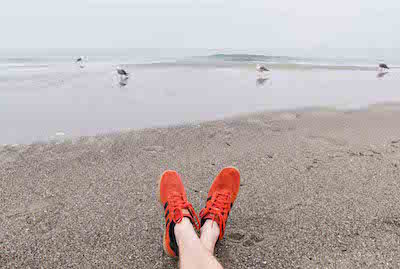 The 5th of December marks a year ago that we left New York for the west coast. Thinking we’d stick it out for three months of a warmer winter, it’s now been a year and we’ve yet to return permanently. Trading scarves and gloves for flip-flops and endless Vitamin D was a fabulous decision for both our respiratory systems and attitudes. There’s got to be a reason San Diego is called ‘America’s finest city’ and we wanted to find out why.
The 5th of December marks a year ago that we left New York for the west coast. Thinking we’d stick it out for three months of a warmer winter, it’s now been a year and we’ve yet to return permanently. Trading scarves and gloves for flip-flops and endless Vitamin D was a fabulous decision for both our respiratory systems and attitudes. There’s got to be a reason San Diego is called ‘America’s finest city’ and we wanted to find out why.
We arrived just shy of New Years last year, so this is our first full holiday season spent in the country’s southwest corner. If you’re looking for a place in the United States that’s a warm weather spot with outdoor living year round, this is it. There’s heaps to do year ‘round and the holiday season is no different. Having married an Aussie, it makes sense to us to be in shorts and tank tops at this time of year – but mostly when we’re on the other side of the world. This is different.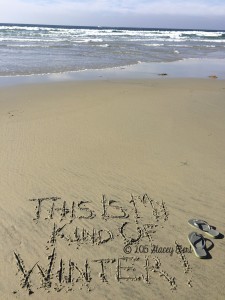
If you want winter to feel more like summer, this is the place. Take advantage of the warm days and cool evenings while you continue to spend your days outside breathing the ocean infused air. Most restaurants and bars have rooftops and heaters so your summer attitude can continue 12 months of the year. Hang with the locals on the beaches, visit animal friends at the San Diego Zoo and Sea World, hike to Cabrillo Point to check out the tide pools and maybe see some whales, celebrate the holiday spirit at Balboa Park December Nights or Major League Baseball’s Petco Park’s Holiday Wonderland and enjoy a southern California play on winter while ice skating overlooking the sand at the Hotel Del Coronado.
Farmers markets continue, surfers rarely don anything heavier than a rash guard, waterside picnics constantly happen with limited layering if any necessary and Vitamin D reigns supreme. Golfers, hikers, paddle boarders, runners, kayakers, and triathletes share their paths with amateurs year ‘round. Life continues to happen outdoors. This does, of course, happen in other cities around the Northern hemisphere simultaneously; but, it’s that it happens here with continuous summer flair. The oddest thing to get used to is locals ‘freezing’ and donning socks, Uggs and scarves when the temperatures dip below 65 degrees Farenheit. Don’t get me wrong…I’m climatized and happy about it!
This is the place where you can go grab that white Christmas atop Big Bear or nearby Julian and have dinner sans jacket overlooking the sea at La Jolla cove all in the same day. Or trade the thought of white snow for white caps of waves and spend Christmas day with your toes in the sand as revelers celebrate around you doing exactly the same thing. If you’re looking to ditch the diving temperatures, deafening wind chills and ascending snow tallies, San Diego is a spot to kick off those gloves and jackets and jump right in to sunshine. Hope to see you here.
Suggestions for your San Diego experience year ‘round
Beaches: Pacific, Ocean, Mission, Coronado
Local trails: Balboa Park, Torrey Pines, Mission Regional, Cowles Mountain
Road trip to trails: Joshua Tree, Anza – Borrego, Big Bear, Julian
Eats: fish tacos at Blue Water, burgers at Hodads, southern California breakfast at Snooze or trendy spots in the Gaslamp
Drink: Craft Beer Breweries (Mission, Ballast Point, Stone plus others)
Experience: Sea World, San Diego Zoo, Balboa Park, Old Town Trolley Tour, Seaport Village, Coronado, Gaslamp Quarter
Spots to hang: Point Loma, La Jolla, Downtown, Pacific Beach, Ocean Beach
Farmers Markets: Little Italy, Hillcrest, La Jolla, El Cajon
Hop across the border: Visit Mexico
Suggestions for your holiday San Diego experience
Holiday Wonderland at Petco Park
Balboa Park December Nights
San Diego Zoo Jungle Bells
The Old Globe presents How the Grinch Stole Christmas
Hotel Del Coronado DELights
San Diego Bay Parade of Lights
Port of San Diego Holiday Bowl Parade
Planning a RTW trip?
Sign up for the free e-course >
Follow more of Stacey’s musings on her blog.
Photo Credit: Blake Bronstad
Original article can be found here: A winter-summer in San Diego, California
December 8, 2015
Are Travel Bloggers Journalists?
About a year ago, I received an email from a woman whose name I didn’t know and cannot now recall. The crux of her dogmatic email was to “inform” me of the true definition of a journalist, and why a travel blogger/writer should not be so presumptuous as to use that title. I replied that I had never used that title, that I considered myself a travel writer. She replied, “Oh, I thought you were one of those who represent themselves as a journalist.”
I hit delete and didn’t give the matter much thought for a couple of years, until my writing style began to evolve. Up to that point, I’d focused on the culture of the destinations I visited, featuring stories about food, language, customs, religion, fashion, architecture, art, music, and dance. The deep, long-lasting friendships I formed with local people often led to frank discussions about the history and politics of a region, and how their lives were influenced by both. It was inevitable that my writing would become more journalistic in nature.

Dalai Lama, at the opening session of the 2010 Kalachakra for World Peace conference in Washington D.C.
My first foray into journalistic writing may have been in 2010, when I was invited to be a member of the press corps covering the Dalai Lama, who was in Washington D.C. to bestow the Kalachakra initiation upon 14,000+ followers of Tibetan Buddhism. Since then, I have covered political demonstrations in Nepal, written about Hungary’s ongoing attempt to rewrite their World War II history, about the secret war in Laos that left the country with tons of unexploded ordinance that still kills and maims thousands of people each year. Most recently, I wrote a fairly scathing piece about the woefully inept government tourism agencies in Slovenia.
At the same time, the question of whether travel bloggers/writers are journalists is being more stridently discussed within our industry. My initial detractor insisted that one must have a degree in journalism from an accepted university before using the title, but when I looked up the definition I found no such restriction.
Merriam Webster defines a journalist as:
a : a person engaged in journalism; especially: a writer or editor for a news medium
b : a writer who aims at a mass audience
c: a person who keeps a journal
Certainly, I qualify in all three cases, especially since I have been published in numerous print magazines, newspapers, and online news sites. But do I meet the criteria set forth by professional associations who represent journalists? The American Press Institute defines journalism as, “the activity of gathering, assessing, creating, and presenting news and information. It is also the product of these activities.” They go on to state that two things separate journalists from the average person.
“The first is motive and intent. The purpose of journalism is to give people the information they need to make better decisions about their lives and society. The second difference is that journalism involves the conscious, systematic, application of a discipline of verification to produce a “functional truth,” as opposed to something that is merely interesting or informative. Yet while the process is critical, it’s the end product – the “story” – by which journalism is ultimately judged.”

Nepali people demonstrate against political strikes that debilitate the country as it tries to promulgate a new constitution
In this era of round-the-clock news, when everyone has the ability to snap a photo or upload a blog post, defining who is or is not a journalist may be the wrong question. According to the American Press Institute, journalism can be produced by anyone, however “the journalist places the public good above all else and uses certain methods – the foundation of which is a discipline of verification – to gather and assess what he or she finds.”
The Society of Professional Journalists appears to agree. A resolution submitted to and approved by the Excellence in Journalism Conference in Anaheim, CA. on August 26, 2013 states, “the Society believes that journalists should not be defined by the mediums in which they work, the percentage of their incomes derived from journalism work, their education, their employer, or any other specific criteria that would limit their abilities to inform the citizenry.”
While the bulk of my writing is still travel related, what most intrigues me are situations that allow my writing to have a distinctly journalistic bent. And yes, I now consider myself a journalist. Looking back, I always have been.
Ready plan your RTW trip?
Sign up for the free e-course >
When Barbara Weibel realized she felt like the proverbial “hole in the donut” – solid on the outside but empty on the inside – she walked away from corporate life and set out to see the world. Read first-hand accounts of the places she visits and the people she meets on her blog, Hole in the Donut Cultural Travels. Follow her on Facebook or Twitter.
Photo Credit: Rhianon Lassila
Original article can be found here: Are Travel Bloggers Journalists?
December 1, 2015
Indonesia’s gili islands
The Gili islands consist of three small tropical paradises, each with its own personality. The islands are just northwest of the larger island of Lombok. Gili Trawangan is perfect if you’re looking to party and make new friends. Good for backpackers, Gili T has a wealth of bars, parties, and magic mushrooms. Gili Meno is in the middle, is almost deserted, and is perfect for a quiet visit if you’re looking to pass out on the beach and spend quality time with someone or be alone. Gili Air is a mix of the other two. Less parties than Trawangan and more developed than Meno with lots of boutique shops.
It’s easy to find a deserted beach on Meno or Air. No shortage of palm trees in the Gilis.
Deserted beaches.
A slower pace.
Many expats have settled on the Gilis and started western restaurants and shops making it easy to find Italian pizza, Swedish meatballs, or even authentic Thai food.
Anyone who has revisited any of the Gilis knows that development never stops. New shops, restaurants, and bungalows pop up every month. You can’t walk down the street without seeing a horse cart full of cement bags or cinder blocks.
The only way to get around on the islands is to walk, bicycle, or take a horse cart. Motorized vehicles are banned on the island. the only sound you hear on the street is bicycle bells and the jingling of bells on the horses.
Ending the day on any Gili will give you spectacular sunsets and views of Rinjani on Lombok.
Whichever Gili you visit you will have the opportunity to dive, snorkel, drink, party, relax, sunbathe, eat, and bicycle.
Ready plan your big trip?
Sign up for the free e-course >
Maryanne currently lives on Gili Trawangan working as a dive instructor. For more photography visit her portfolio on Tumblr.
Header Image Credit: Dima Fadeev
Original article can be found here: Indonesia’s gili islands
Rolf Potts's Blog
- Rolf Potts's profile
- 323 followers


